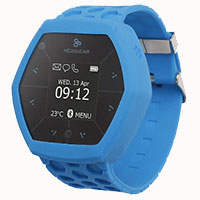Kinetis Potential in Secure Wearable Applications
With NXP’s acquisition of Freescale they procured their entire product portfolio including the Kinetis line of microcontroller products. One particular family, the Kinetis K8x MCUs, is particularly interesting regarding one of its target applications: smart wearable devices. This is one of the hottest applications in the technology world today and the Kinetis K8x MCUs are ideal candidates for being incorporated into designs in this field.
The main difference the Kinetis K8x family offers over other MCUs in the Kinetis line is its advanced security. In the today’s Internet of Things (IoT) climate, security is becoming more of a concern since everything in our connected world is potentially accessible through the web. No one wants prying eyes on their private information or hackers taking over their devices for nefarious purposes. Therefore, the advanced security that the Kinetis K8x family offers would be ideal for wearable and other portable device designs.
These advanced security capabilities include boot ROM to support encrypted firmware updates, support for public key cryptography, hardware AES acceleration with side band attack protection, and automatic decrypt and execute from external NOR Flash memory. All of these security improvements were added while keeping a high level of backward compatibility to prior versions of Kinetis devices.
The low power consumption of the K8x family is also a must for today’s wearable/portable devices. These devices require only 210 µA/MHz in low-power operation with dynamic currents and only require a miserly 5 µA in state retention mode. Additionally, smart on-chip integration provides substantial BOM savings.
To top it all off, the Kinetis K series is supported by a comprehensive set of development tools, software, and enablement including the Freedom K82 development platform (shown below).
 NXP's Freedom K82 Development Platform
NXP's Freedom K82 Development Platform
This is a low-cost board that can be used as a development platform for the Kinetis K82, K81, and K80 devices. It is form-factor compatible with the Arduino™ R3 pin layout which enables the use of a wide range of expansion boards. Furthermore, rapid prototyping is enabled by peripherals such as a six-axis digital accelerometer and magnetometer (for full eCompass capabilities), a tri-colored LED and two user push-buttons for direct interaction, 2x32Mb QuadSPI external flash, a FlexIO camera header, and touch pads and headers for use with Bluetooth® and 2.4 GHz radio add-on modules. Using this board to develop and prototype your application quickly can significantly reduce project time to market.
In addition to smart wearable devices, the Kinetis K8x family of MCUs has a promising future in other applications such as portable health and fitness devices, gaming controllers, smart home automation and security, building control, point-of-sale devices, and activity and wellness monitors.
If you’re looking for an MCU that offers low-power consumption, easily available development tools, and that is secure from prying eyes, the Kinetis K8x family is highly worth your consideration.

Have questions or comments? Continue the conversation on TechForum, DigiKey's online community and technical resource.
Visit TechForum










